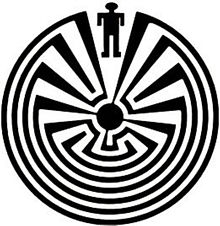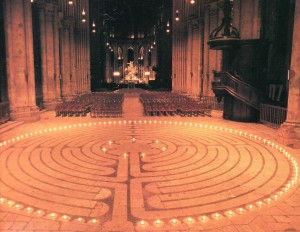Do you like labyrinths? They’ve always fascinated me. Here’s a very basic overview.
The classical labyrinth is a circular pathway with one long continuous path making 7 circuits. From the entrance, you are led to the center with many turnings but no side paths or dead ends. At the center you turn around and go back out the way you came in.
Labyrinths were prevalent and important in many ancient cultures. They meant many things to many people. Today there is a renewal of interest in labyrinths, you’ll find lots of information at The Labyrinth Society and other guides online.
Here are some of the ancient cultures that loved labyrinths –
 Ancient Greece (2000 – 1400 BC ) ~ Labyrinths are featured in the ancient Greek myth of the Minotaur and Daedalus. You can read all about it here The Minotaur. Basically, the Minotaur of Greek mythology was part man and part bull, a beast that demanded human sacrifice. The architect Daedalus built the labyrinth to hold the Minotaur for King Minos of Crete. Daedalus and Theseus came up with a plan to kill the Minotaur. Theseus volunteered to be sacrificed, then killed the beast and escaped. Read more about the search for the actual labyrinth on Crete http://ancientworldwonders.com/minoan-labyrinth.html
Ancient Greece (2000 – 1400 BC ) ~ Labyrinths are featured in the ancient Greek myth of the Minotaur and Daedalus. You can read all about it here The Minotaur. Basically, the Minotaur of Greek mythology was part man and part bull, a beast that demanded human sacrifice. The architect Daedalus built the labyrinth to hold the Minotaur for King Minos of Crete. Daedalus and Theseus came up with a plan to kill the Minotaur. Theseus volunteered to be sacrificed, then killed the beast and escaped. Read more about the search for the actual labyrinth on Crete http://ancientworldwonders.com/minoan-labyrinth.html
 The Roman Empire (27 BC – 476 AD) ~ In the times of the Roman Empire, labyrinths grew in popularity as a design element in private homes. Depicted regularly in mosaic flooring, the labyrinth was most often used for private meditation but also for group rituals.
The Roman Empire (27 BC – 476 AD) ~ In the times of the Roman Empire, labyrinths grew in popularity as a design element in private homes. Depicted regularly in mosaic flooring, the labyrinth was most often used for private meditation but also for group rituals.
 Native America ~ (1700 – ) The Tohono O’odham Nation of Southern Arizona have a story about the Man in the Maze. It represents the journey of life, with major turns at childhood, adolescence, adulthood, and old age. The center represents death and the beginning of a new journey as the cycle of life continues.
Native America ~ (1700 – ) The Tohono O’odham Nation of Southern Arizona have a story about the Man in the Maze. It represents the journey of life, with major turns at childhood, adolescence, adulthood, and old age. The center represents death and the beginning of a new journey as the cycle of life continues.
 Gothic Cathedrals (1100-1300) ~ While the original purpose of the labyrinths in medieval cathedrals is not clear, the church uses the labyrinth as an analogy for the path to salvation. Walking these labyrinths can substitute for a longer pilgrimage. Today ritual dances are performed on the labyrinths as part of Easter celebrations. Read more about Gothic Cathedrals and their labyrinths at Gothic Cathedrals
Gothic Cathedrals (1100-1300) ~ While the original purpose of the labyrinths in medieval cathedrals is not clear, the church uses the labyrinth as an analogy for the path to salvation. Walking these labyrinths can substitute for a longer pilgrimage. Today ritual dances are performed on the labyrinths as part of Easter celebrations. Read more about Gothic Cathedrals and their labyrinths at Gothic Cathedrals
 Spiritual people today see the labyrinth as a path to enlightenment. Walking the path is meditative and helps quiet the mind, leaving the outside world behind. When you follow the paths, back and forth, back and forth, your right brain activity is enhanced. You’ll find them in gardens and parks everywhere.
Spiritual people today see the labyrinth as a path to enlightenment. Walking the path is meditative and helps quiet the mind, leaving the outside world behind. When you follow the paths, back and forth, back and forth, your right brain activity is enhanced. You’ll find them in gardens and parks everywhere.
Labyrinths inspired me to draw a series of art cards (2×3″) I call “Pathways” that are continuous paths. I decided I wanted to go on a continuous path rather than in and out.
What do you think? Do you like the continuous pathway or prefer to follow the historic labyrinth pathway in and out? Do you like the paths that go over and under? You can get free downloads of several of my Pathways series in my Doodles folder at DeviantArt
I hope you enjoyed my post about labyrinths. A few of my fellow bloggers here on WordPress have blogs dedicated to labyrinths. Here are the links to a few of my favorites. I’m sure they’d love to share their posts with you.
Guerrilla Labyrinths https://wordpress.com/read/blog/id/4092648/
LABYRINTHOS https://wordpress.com/read/blog/id/659544/
blogmymaze https://wordpress.com/read/blog/id/3078728/
Watch for my next blog coming soon…. “The Amazing Maze”.








